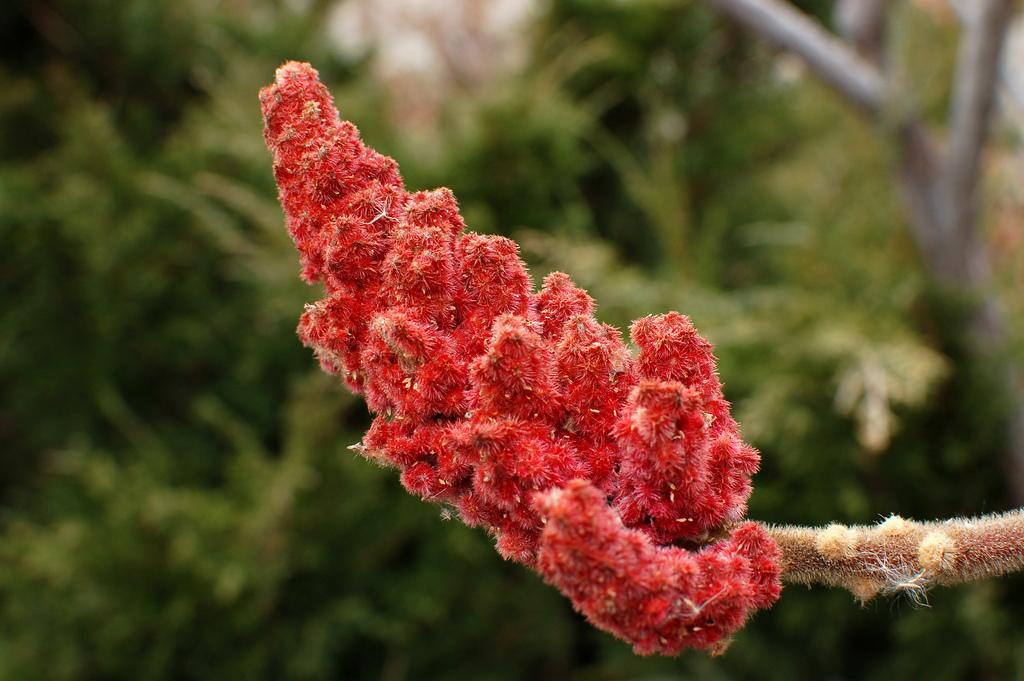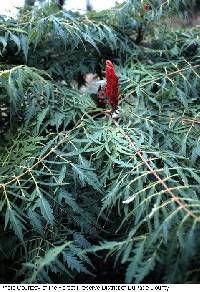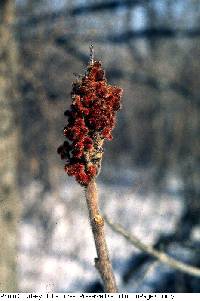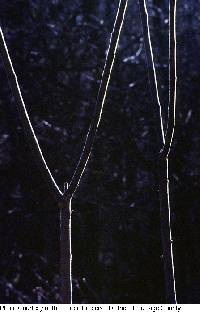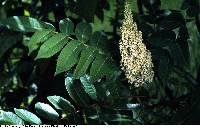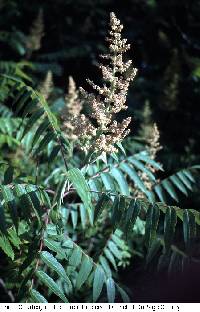|
|
|
|
Family: Anacardiaceae
staghorn sumac
[Datisca hirta L., nom. utique rej., moreRhus hirta (L.) Sudw., Rhus typhina var. laciniata Alph.Wood] |
Small tree or large shrub to 10 m tall Leaves: alternate, pinnately compound, 20 cm - 0.6 m long, with nine to 29 (often ninteen) leaflets. The stalk is stout, 3 - 10 cm long, densely hairy, and encloses the bud with its enlarged base. Flowers: male and female, borne on separate plants (dioecious), sometimes with unisexual and bisexual flowers (polygamous). The inflorescence is large (20 - 30 cm long), terminal, and branched (panicle) with hairy stalks and tiny yellowish green flowers. Female panicles are more compact than male panicles. Fruit: fleshy with a center stone (drupe), found in dense upright clusters, red, 3 - 5 mm across, covered with numerous red needle-like hairs (2 mm long or longer), persisting most of the winter. Bark: dark brown to gray, smooth, sometimes dividing into small square scales. Twigs: stout, brown, rounded, covered in dense velvet-like hairs (1 - 2 mm long), exuding a milky yellowish sap when cut. The horseshoe- to C-shaped leafscar almost encircles the bud and has three bundle scars. Buds: small, about 6 mm long, cone-shaped, with velvety pale brown hairs. The terminal bud is absent. Leaflets: nearly stalkless (terminal leaflet stalk longest), opposite or with lower leaflets slightly alternate, 5 - 12 cm long (middle leaflets longest), 1.5 - 3.5 cm wide, lance-shaped to oblong with a rounded to slightly heart-shaped base and a pointed tip, sharply toothed (sometimes few), with short hairs underneath the midvein. Emerging leaves are covered in red hairs, become bright yellowish green, and later change to dark green above and pale to nearly white beneath. Fall color yellow, red, purple, or orange. Form: rounded to flat-topped, forming an open to dense colony from root sprouts. Similar species: Rhus glabra is very similar to Rhus typhina but has hairless twigs and warty to club-like hairs (less than 0.5 mm long) on its fruit. Rhus x pulvinata is a hybrid between R. typhina and R. glabra with intermediate characteristics. It is quite difficult to identify without the fruit, which has both needle-like and club-like hairs. Rhus copallina is also similar, but the leaf stalk is winged between the leaflets. Toxicodendron vernix differs by its non-toothed leaves and white fruit. Flowering: early June to mid July Habitat and ecology: Occasional species that is definitely native to the eastern counties of our region. Many of the western populations have probably escaped from cultivation, since the species is often planted as an ornamental. It grows along rocky slopes, moist lake shores, edges of dry woods, fencerows, roadsides, sandy barrens, thickets, and old fields. Occurence in the Chicago region: native Notes: Rhus typhina is very shade intolerant and is often planted along highways and in waste places. It sprouts from roots after a fire, and is difficult to remove from a site. Tannic acid was once extracted for tanning leather, and pipes made from young twigs were once used to extract sap from sugar maples. The resemblance of the twigs to a stag's "horns"give Rhus typhina the common name staghorn sumac. Etymology: Rhus is the Greek name for a species of sumac. Typhina refers to the resemblance of its velvety branches to Typha, cattail. Author: The Morton Arboretum Tall shrub or small tree to 10 m; younger branches, petioles, and lf-rachis densely and softly hirsute; lfls 9-29, lanceolate to narrowly oblong, 5-12 cm, acuminate, serrate, paler beneath; frs 4-5 mm, somewhat flattened, red, densely covered with slender, tapering hairs 1-2 mm. Dry, open places; N.S. and s. Que. to Minn., s. to W.Va. and O., and irregularly to n. Ga., n. Ala., and Io. June, July. (R. hirta) Gleason, Henry A. & Cronquist, Arthur J. 1991. Manual of vascular plants of northeastern United States and adjacent Canada. lxxv + 910 pp. ©The New York Botanical Garden. All rights reserved. Used by permission. |


